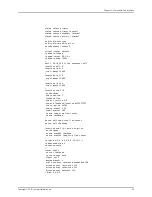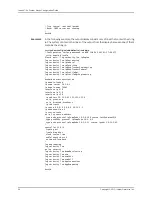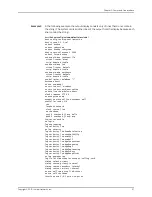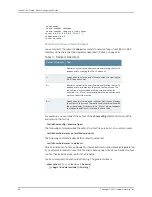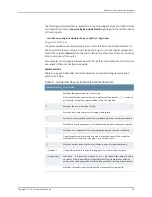
Privilege level is 5
•
There is no
no
version.
•
See disable.
Logging Out
You can log out of the CLI from either the User Exec and Privileged Exec modes by entering
the
exit
command. For example:
host1>
exit
logging out.
or
host1#
exit
logging out.
CLI Command Privileges
You can change the privilege level of most commands by using the
privilege
command
that is available in Global Configuration mode. To use this command, you must enable
your CLI session to privilege level 15.
CLI Privilege Groups
You can change privilege group accessibility. Privilege groups are no longer required to
be hierarchical. You can modify the privilege group membership and define which privilege
group is a member of another privilege group.
A privilege group can contain commands and other privilege groups as members. A group
always has access to commands in its own privilege group and in privilege group 0. By
default, all groups have one member and a specific privilege group has access to all
commands in all privilege groups with a lower number than the specific group.
A privilege group is reachable from another privilege group when it is a member of that
privilege group, or a member of a group that is a member of that privilege group until a
search of all member groups is exhausted. This can go through several recursions as long
as there are no circular dependencies.
Privilege group 0 is not a member of any group and you cannot assign member groups
to it, but it is reachable from every privilege group.
Numbers in the range 0—15 identify the 16 privilege groups. Each of the 16 groups can
have a name or an alias. The default internal name is the privilege group number. By
default, the groups are hierarchical and each group, with the exception of groups 1 and
0, contains one group. When a group contains a group, the contained group is a member
of the original group: privilege group p has one member, privilege group p-1. For example,
privilege group 15 has member 14, privilege group 14 has member 13, and privilege group
2 has member 1.
49
Copyright © 2010, Juniper Networks, Inc.
Chapter 2: Command-Line Interface
Summary of Contents for JUNOSE 11.3
Page 6: ...Copyright 2010 Juniper Networks Inc vi...
Page 8: ...Copyright 2010 Juniper Networks Inc viii JunosE 11 3 x System Basics Configuration Guide...
Page 24: ...Copyright 2010 Juniper Networks Inc xxiv JunosE 11 3 x System Basics Configuration Guide...
Page 32: ...Copyright 2010 Juniper Networks Inc 2 JunosE 11 3 x System Basics Configuration Guide...
Page 146: ...Copyright 2010 Juniper Networks Inc 116 JunosE 11 3 x System Basics Configuration Guide...
Page 166: ...Copyright 2010 Juniper Networks Inc 136 JunosE 11 3 x System Basics Configuration Guide...
Page 432: ...Copyright 2010 Juniper Networks Inc 402 JunosE 11 3 x System Basics Configuration Guide...
Page 488: ...Copyright 2010 Juniper Networks Inc 458 JunosE 11 3 x System Basics Configuration Guide...
Page 524: ...Copyright 2010 Juniper Networks Inc 494 JunosE 11 3 x System Basics Configuration Guide...
Page 554: ...Copyright 2010 Juniper Networks Inc 524 JunosE 11 3 x System Basics Configuration Guide...
Page 566: ...Copyright 2010 Juniper Networks Inc 536 JunosE 11 3 x System Basics Configuration Guide...
Page 588: ...Copyright 2010 Juniper Networks Inc 558 JunosE 11 3 x System Basics Configuration Guide...
Page 613: ...PART 3 Index Index on page 585 583 Copyright 2010 Juniper Networks Inc...
Page 614: ...Copyright 2010 Juniper Networks Inc 584 JunosE 11 3 x System Basics Configuration Guide...
Page 632: ...Copyright 2010 Juniper Networks Inc 602 JunosE 11 3 x System Basics Configuration Guide...

